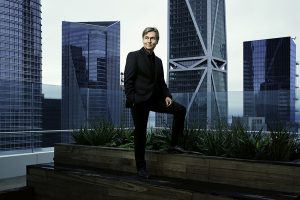SF Symphony ventures virtually with Esa-Pekka Salonen, collaborators
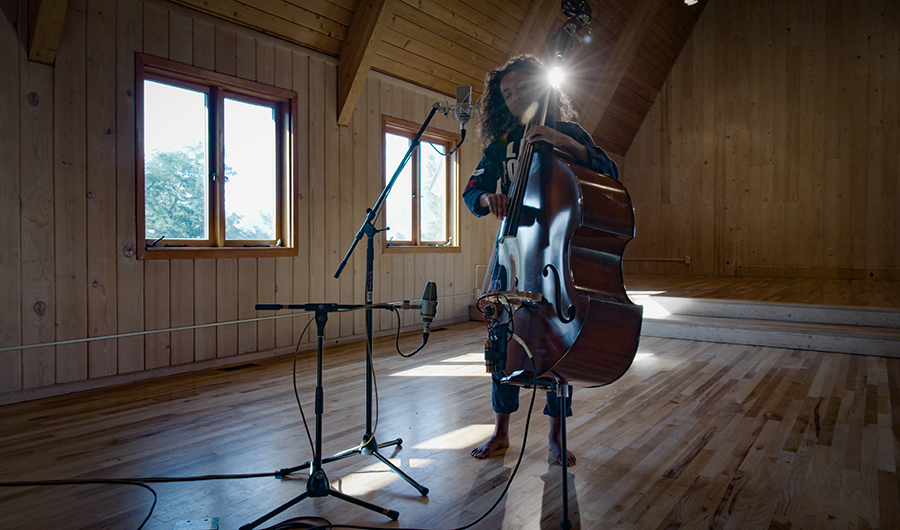
Esperanza Spalding performs in “Throughline: San Francisco Symphony—From Hall to Home.” Other artists highlighted include Bryce Dessner of The National and violinist Pekka Kuusisto. Courtesy: SF Symphony.
After Esa-Pekka Salonen was named to fill the shoes of Michael Tilson Thomas as music director of the San Francisco Symphony in 2018, he announced a team of eight all-star creative collaborators to provide inspiration. At the time, the organization couldn’t have predicted that it would rely on introducing the entire team remotely in what is essentially a kickoff to the symphony’s 2020-21 orchestral season. That is “Throughline.”
Throughline: San Francisco Symphony—From Hall to Home
7 p.m., Saturday, Nov. 14 on KQED
Rebroadcast at 7 p.m. on Nov. 30 on NBC Bay Area
Also streaming at the SF Symphony’s website.
The SF Symphony commissioned classical and film composer Nico Muhly, one of the eight, to create a work highlighting each of the partners, as well as several orchestra musicians, on Aug. 6. By Sept. 20 recording sessions began. With the announcement on Monday that all in-person concerts at Davies Symphony Hall have been canceled through June 2021, the organization will need to dive further into virtual opportunities.
“The ‘Throughline’ project is one embodiment of this group of eight weirdos that Esa-Pekka has assembled for his advisory committee,” said virtuosic violinist Pekka Kuusisto, one of the eight, and who, like Salonen, is Finnish. “It’s a small, really fun, really beautiful part of something that will hopefully grow into a much larger thing once the pandemic is done.”
The symphony’s collaborative partners include The National guitarist, composer and arranger Bryce Dessner; acclaimed jazz musician Esperanza Spalding; Kuusisto; soprano Julia Bullock; flutist Claire Chase, founder of the International Contemporary Ensemble; composer and pianist Nicholas Britell, known for his work on the films “Moonlight” and “If Beale Street Could Talk,” as well as the HBO series “Succession;” and Carol Reiley, a computer scientist and roboticist.
Each partner, including Muhly and Salonen, gets their own moments to shine in the 19-minute, 13-movement “Throughline,” which premieres Nov. 14 on SF Symphony’s website and will be broadcast on KQED alongside works by Ellen Reid, John Adams and Beethoven, and a new performance of Kev Choice’s “Movements,” which premiered in September as part of the symphony’s Currents series.
It’s no ordinary streamed performance.
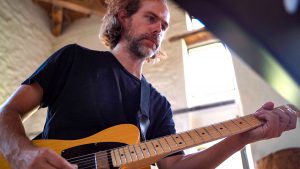
Bryce Dessner of The National performs in “Throughline: San Francisco Symphony—From Hall to Home.” Courtesy: SF Symphony.
“Throughline” is hundreds of hours in the making, with recording sessions spread throughout the world. While members of the San Francisco Symphony were recorded at an empty Davies Hall, up to a handful at a time, the soloists were filmed by local crews remotely.
Muhly, who not only wrote the music but oversaw its execution views the experience as “a strange gift received in strange times.” He faced numerous restrictions from labor unions, COVID restrictions, space and time constraints, and orchestra personnel rules, and used them to create a structure for the music.
“The tricky thing was designing a piece where the continuity of it made sense; so it didn’t feel like it was something that was kind of disciplined by the restrictions, but actually the restrictions themselves were a kind of space through which the music could elegantly flow,” he said. “I kind of memorized the restrictions and treated that like architecture. … It’s strange rules, but it’s different customs in different times. In that sense, it was actually quite similar [to what I’m used to]. The super crazy thing actually for me was how quickly I wrote it.”
Muhly wrote all but two of the 13 segments himself.
He provided Reiley with several inputs, which she input in an artificial intelligence entity. The AI program applied its own musical logic to it to produce music. He then rearranged it for the three instruments playing the piece: a celesta, bass and vibraphone. The composer compared the experience to a music conservatory exercise where students are given a cantus firmus and then have to react to it.
Spalding composed all of her own segment, which was finalized the day before recording. Muhly said that she and Reiley were the only two artists he had never worked with, and he let Spalding create her piece out of respect for her as an accomplished composer. Perhaps it would have been different had the two been allowed to create together in the same room, he said. Her piece includes a vocal improvisation, without words.
“The expressive power of not using words, I think, is sometimes more poetic than what actual lyrics could do,” he said.
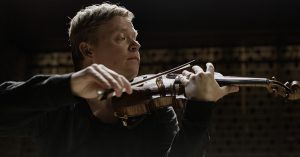
Pekka Kuusisto performs in “Throughline: San Francisco Symphony—From Hall to Home.” Courtesy: SF Symphony.
Muhly has worked with all of the other collaborative partners and is actually good friends with both The National’s Dessner and violinist Pekka Kuusisto. Speaking in a combined video call from southern France, which he now calls home, Dessner said joining Salonen’s brain trust at the SF Symphony was a no-brainer even though he’s “spoiled” from working with numerous orchestral organizations.
“It’s always interesting to work with Nico,” Dessner said. “It’s always surprising, and [there’s] always a sparkle in his eye, a bit of whimsy and cleverness and mischief.
“The combination of Esa-Pekka Salonen and San Francisco Symphony in a city with such an incredibly open and vast culture I think is kind of the magic formula for being able to really take big risks and experiment,” he said.
Dessner added that Salonen is in a unique position, due to his experience, his vision, and the pandemic, to shake up the orchestral genre.
“None of us know exactly how this is going to go or what tomorrow will bring, but for sure it’s that the kind of possibility of change and a forward-thinking experiment that is exciting,” he said. “San Francisco is really the city in America to do that.”
Kuusisto, speaking from northern Karelia, next to the Russian border, was excited at the risk involved in the entire project; not just “Throughline” but the collaborative partner approach. At any time, the whole scheme can fall apart if people become complacent, he said, especially because Salonen himself is often busy.
“They need to have somebody at the office who is kind of cracking the whip at all of us to make sure that we send them stupid ideas that they can then refine and build on,” he said.
“The postponement of everything, everywhere, including ‘Frisco, is really painful. Especially with the fantastic rule of Michael Tilson Thomas coming to an end,” he said. “I’m sure there was supposed to be a giant going-away party for him and then a huge-ass coronation for Esa-Pekka. This is sort of the way that things are usually done in the major symphony orchestra world. The fact that we really can’t do that now at all and have to come up with something completely different might be accidentally the best possible starting point for whatever Esa-Pekka’s job at the orchestra and participation in it can cause.”
Kuusisto’s segment, which kicks off “Throughline,” was recorded at a music center in Helsinki. Because the violinist works so closely with Muhly, the two were already on the same page, so that by the time he received his music, it felt like something that was written specifically for his instrument, he said. It was filmed by a team with whom he was already familiar, and the recording was “smooth sailing,” he said.
Bullock, meanwhile, had told the New York Times that her session required several stops and starts and faced technological hiccups along the way, leading to hours spent in the studio. She performed a poem by 17th century English poet Thomas Traherne.
Dessner, who’s made several albums with Muhly, said he felt like the composer was testing him on his minute-long segment.
“The difference between me and Pekka is he one of the greatest virtuosos in the world; one of the best musicians on the planet. I am a composer, and I’m a decent guitar player, but I would not say that I necessarily get hired for my virtuosic guitar playing,” Dessner said. “My part, while just a minute long, is exceptionally difficult. It never plays the same pattern twice. It makes Steve Reich’s music look easy. It sounds a little bit like ‘Electric Counterpoint,’ but it’s much more difficult. I think that’s a little bit of Nico winking at me. He’s sort of putting me in the hotseat.”
Dessner’s segment includes brass and electric bass accompaniment, which he explains is Muhly setting the scene. He ended up making a couple of tweaks to the music because the original would have taken him a year to perfect.
“I had about 10 days to practice it, maybe a little less,” he said.
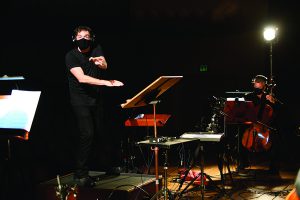
Composer Nico Muhly (left) conducts “Throughline: San Francisco Symphony—From Hall to Home.” Courtesy: Kristen Loken.
The guitarist recorded the segment at a studio built for French pianists Katia and Marielle Labèque. He works with them and at that location often, he said. This recorded performance was one of the few he’s recorded or streamed during the pandemic.
“To be honest, I’ve been asked to do other sort of livestream things, and I’ve mostly said ‘no,’ but the fact that this was really conceived for this new medium and by Nico, whose brain really functions in this way to begin with. … He can think in several universes, at the same time, so it sort of made sense to me that he would do something like this with his music.”
The filming locations were chosen carefully for all of the soloists. Britell was filmed in L.A., Bullock in Munich and Chase’s segment took place in the back room of The Kitchen, an experimental music venue in New York. Spalding performed in church or cabin in northern Oregon. Orchestra musicians, and Muhly, were filmed at an empty Davies Symphony Hall in San Francisco.
Muhly said he feels personal connections to several of the locations used for filming because he’s written music there as well.
“Having these other spaces, all different sizes, all different places, was this really emotional grounding thing for me and reminded me of the ‘before times’ when I could have flown there in an airplane,” he said.
The final segment takes place outdoors—it shows Salonen walking through a forest outside of Helsinki, physically interacting with nature, as if he’s conducting the foliage, berries, stones and a river.
The new music director needed to be included, but filming him pretend-conducting would have been the wrong move, Muhly said. So he decided to make a connection between the mundane actions of Salonen and the music being performed. It could have come off as cheesy, but because of the musical director’s expressive conducting, it came off as both natural and ritualized.
Q&A: What is your next role as an SF Symphony collaborative partner?
Pekka Kuusisto: It sort of depends on how the world works, but I think there’s a plan for a bunch of us to converge in June. I think I would at least play something with the symphony, and then some of us would figure out something fun to do together and sort of stay in town for a little while, which would be lovely. But it’s of course all a little bit up in the air.
Bryce Dessner: I am actually in the middle of writing a concerto for Pekka. So directly, that’s the two of us with the symphony. It’s supposed to be in June, but we’ll see if it’s possible.
“This is his first thing. This is the opening of his season,” Muhly said. “There’s a real bizarre-like poetry to the fact that he couldn’t be there. So we had to forge this connection between that berry outside of Helsinki and that harp harmonic [being played].”
While there’s no specific story being told on “Throughline,” Muhly wanted to show how symphonic music could be made in a chamber music way—even if it’s impossible to perform a piece like this live.
The first segment, for example, includes a violin, viola, harp, glockenspiel and piccolo. In an orchestra setting those musicians would be 30 feet apart and would be difficult to conduct and manage with precision. But through this film, even though they are thousands of miles apart, they feel closer together.
“The story, in that sense, is these little pictures of things that seem impossible and that sound impossible,” he said.
The soloists weren’t given the full music ahead of time and weren’t told where their parts fell in the runtime. They didn’t know who preceded nor followed them. Muhly stitched all of the segments together and everyone trusted him, Dessner said.
“Even with the title itself, we trusted him to find the throughline,” he said. “Part of the game, maybe, was that we wouldn’t know. I enjoyed that part of it.”
There is a specificity to the way the music evolves. Up until the ninth segment, it’s full of hyperactive movements and playing, but starting with the 10th and continuing to the end, it becomes more simplistic. There’s one repeating chord progression by this point. The piece ends on one repeating chord.
Q&A: Bryce, where can I hear your music next? And what’s next for the National?
Bryce Dessner: I am working on a new score for a film with my brother Aaron and the musician Jon Hopkins. My brother’s producing a lot of records. I often will do arrangement stuff for him. And the National; we’ve written some songs recently. I don’t know how soon we will make an album. We toured a lot in the last five or six years … so we’re all enjoying a bit of time home, and obviously, there are no concerts. So for now, I can’t say that there’s any plans for any. We’re just taking it easy, but we’re all creative in our own ways and the others have a lot going on as well.
“It’s like being dropped into a room and suddenly realizing that there are all these things moving around you in unexpected ways,” he said. “And then at the end, when the whole orchestra’s playing together, we’re outside. We’ve gone through all these little spaces and then after Jules’ song, where we hear actual words … all the walls vanish, all the restrictions vanish and you’re walking through the woods.”
The beauty of the finished film is that it removes the physical distance between the performers. It’s expertly cut to make viewers forget about the reason such a piece was even needed in the first place.
What seems easy was actually very difficult and took hours of work to mix. For the musicians, it meant having to record over a click track. That’s something relatively common in rock music (making songs over DropBox was popular way before the pandemic) but is only now becoming a necessity in classical music, in which precision is much more important.
Kuusisto credits Muhly’s songwriting for working in this way. A Brahams symphony would never work under these circumstances, he said.
“It’s super rare to record classical music so that you would use the studio as an instrument in the way that you would use with most other types of music,” he said. “Placing things in different sort of spaces and different EQs, different reverbs, different everything that is completely common in most other types of music. It’s tricky. … I’m hoping that the profession that I generally find myself in; classical, concert hall music, would sort of inch a bit closer to where the rest of music is happening. There’s more openness to it than ever before. But like with most changes in the world, when you want it to happen, it’s always frustratingly slow.”
Muhly couldn’t think of anyone involved in “Throughline” for whom the project didn’t represent a major structural change in how they think about their job. As with Kuusisto, he also views it as a risk.
Every second of every day had to be massaged by stage management, operations, personnel, artistic management, unions and COVID compliance. But now that it’s been done, it can hopefully create a framework for how it can be recreated. But work is needed to figure out how it can catch on with larger audiences.
“The question then becomes, how do you provide audiences with the same goosebumps—intellectual and emotional and physical—that occur when you’re seeing a symphony all together in this new weird context?” Muhly said.
Follow editor Roman Gokhman at Twitter.com/RomiTheWriter.

